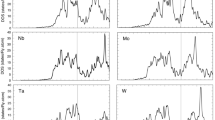Abstract
An angular-force method for bcc transition-metals is obtained by generating a functional form via a quantum-mechanical analysis, and subsequently fitting the parameters in this form to experimental and ab-initio theoretical inputs. The quantummechanical analysis uses a four-moment treatment of the electronic density of states (DOS) in a d-band tight-binding model. Calibration of the method gives excellent results for the bcc-fcc energy difference and the vacancy-formation energy in W. The method is used to treat relaxation and c(2×2) reconstruction on the W (100) surface. The relaxation energy is primarily due to two-body terms, while the reconstruction requires the angular terms. Agreement with ab-initio results is obtained for reasonable values of the parameters in the model. However, the energy difference between the reconstructed surface and the optimally relaxed surface is quite sensitive to the details of the implementation of the method.
Similar content being viewed by others
References
M. S. Daw and M. I. Baskes, Phys. Rev. B 29, 6443 (1984).
M. W. Finnis and J. Sinclair, Phil. Mag. A 50, 45 (1984); Phil. Mag. 53, 161 (1986).
A. E. Carlsson, in Solid State Physics; Advances in Research and Applications, Volume 43, edited by H. Ehrenreich and D. Turnbull (Academic, New York, 1990), p. 1.
J. Moriarty, Phys. Rev. B 38, 3199 (1988).
R. B. Phillips and A. E. Carlsson, Phys. Rev. B 42, 3345 (1990).
J. A. Moriarty and R. B. Phillips, Bull. Am. Phys. Soc. 35, 283, Abstract C8-4, (1990).
F. Ducastelle and F. Cyrot-Lackmann, J. Phys. Chem. Solids 32, 285 (1971).
K. Hirai and J. Kanamori, J. Phys. Soc. Jpn. 50, 2265 (1981).
A. E. Carlsson, P. A. Fedders, and C. W. Myles, Phys. Rev. B 41, 1247 (1990).
These are usefully summarized in W. A. Harrison, Electronic Structure and the Properties of Solids, (Freeman, New York, 1980).
H. L. Skriver, The LMTO Method, (Springer, New York, 1984).
T. Felter, R. A. Barker, and P. J. Estrup, Phys. Rev. Lett. 38, 1138 (1977).
Acknowledgement
We are grateful to Murray Daw, Steven Foiles, and Rob Phillips for enlightening conversations. This work was supported by the Department of Energy under Grant No. DE-FG02-84ER45130.
Author information
Authors and Affiliations
Rights and permissions
About this article
Cite this article
Carlsson, A.E. Semiempirical Angular-Force Method for BCC Transition Metals. MRS Online Proceedings Library 209, 165–170 (1990). https://doi.org/10.1557/PROC-209-165
Published:
Issue Date:
DOI: https://doi.org/10.1557/PROC-209-165




